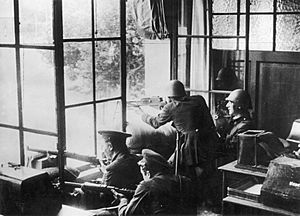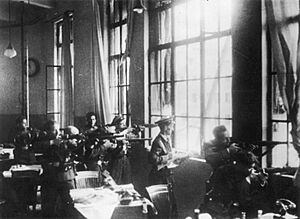July 1936 military uprising in Barcelona facts for kids
Quick facts for kids Barcelona's 19 July military rising |
|||||||
|---|---|---|---|---|---|---|---|
| Part of the Spanish Civil War | |||||||
 Soldiers and Assault Guards entrenched in a building |
|||||||
|
|||||||
| Belligerents | |||||||
| Commanders and leaders | |||||||
| Strength | |||||||
| 5,000 men (Civil Guard, Police, Assault Guard, Mossos d'Esquadra) CNT Militia |
5,000 men | ||||||
| Casualties and losses | |||||||
| 200 | 300 | ||||||
The July 1936 military uprising in Barcelona was a big fight that happened in Barcelona, a major city in Catalonia, Spain. It took place on July 19, 1936. This event was a key part of starting the Spanish Civil War.
Most army officers in Barcelona supported the uprising. But the police forces, like the Civil Guard, the Assault Guard (Guardia de Asalto), and the Mossos d'Esquadra, stayed loyal to the government. This government was called the Republican government. Barcelona was also a strong base for a powerful workers' group called the Confederación Nacional del Trabajo (CNT), which was an anarchist union. The rebel soldiers were defeated after a single day of intense fighting.
Winning this fight in Barcelona was a big success for the Republic. However, after the rebels were beaten, it became clear that the workers' groups, especially the anarchists, were now in charge of the city. This uprising also marked the start of the Spanish Revolution. It also led to harsh actions in Catalonia against anyone thought to be against the revolution.
Contents
Why the Uprising Happened
On July 17 and 18, 1936, a part of the Spanish Army tried to overthrow the government. This government was called the Popular Front. It was the official government of the Second Spanish Republic. A group of generals, including Francisco Franco, led this attempt. One of their main goals was to take control of important cities like Barcelona.
Who Was Fighting
In Barcelona, the rebel leaders, like General Fernández Burriel, planned their attack. They wanted to use about 5,000 soldiers from the IV division of the Spanish Army. These soldiers were supposed to march into the city center and meet up in Plaça de Catalunya. From there, they would take over the city. They also expected General Goded to arrive and join them.
However, General Francisco Llano de la Encomienda, who was the commander of the IV division, stayed loyal to the government. But many other officers in his division supported the coup. The Civil Guard in Barcelona, led by General José Aranguren, also stayed loyal. So did the Guardia de Asalto and the Catalan police, the Mossos d'Esquadra. These loyal forces had about 5,000 men. The El Prat air base also stayed loyal. Its planes even bombed the rebel troops.
On July 18, news arrived that the army in Spanish protectorate in Morocco had started an uprising. But the president of the Generalitat of Catalonia, Lluís Companys, refused to give weapons to the workers. He even ordered that anarchists carrying weapons should be arrested.
Despite this, the CNT, led by Buenaventura Durruti and Francisco Ascaso, took action. They attacked some army storage places and a prison ship. They also started making their own grenades and armored cars. Some Assault Guards even gave rifles to the CNT members.
The Battle in Barcelona
On July 19, very early in the morning, hundreds of civilian volunteers joined the military. Many were Carlist requetés, led by José Cunill. They went to different army barracks. Around 4 AM, officers at the Pedralbes Barrack told their soldiers that the government wanted them to stop an anarchist uprising.
The troops left their barracks and marched towards Plaça de Catalunya. They moved along the Avinguda Diagonal. Soon after, President Companys heard that the troops were moving into the city. At 5 AM, more army units, like cavalry and artillery, also left their barracks. They marched towards Plaça de Catalunya.
However, the rebel troops were not well-coordinated. Their different groups never managed to meet up. Snipers and homemade bombs attacked the rebel soldiers. The anarchists quickly built barricades using paving stones. These barricades blocked the city center. The Civil Guard and the Assault Guards joined the anarchists to fight the rebel troops.
Some rebel units had to go back to their barracks. Others never even made it into the streets. But one group of infantry, led by Major Lopez Amor, reached Plaça de Catalunya. They took over the telephone exchange. Other rebel units occupied the Hotel Colón and the Ritz and built barricades there.
At 11 AM, General Goded arrived from Mallorca. He went to the main military headquarters. He arrested General Llano de la Encomienda, who was the commander of the IV Division. But by then, the rebel troops were in a hopeless situation.
After fierce fighting in Plaça de Catalunya and other parts of the city, the anarchists and loyal troops surrounded all the buildings held by the rebels. The Civil Guards, led by Colonel Antonio Escobar, attacked the Hotel Colón and the Ritz. The anarchists took over the telephone exchange.
After this, General Goded gave up. He made a radio announcement to stop more bloodshed. By nightfall, the rebel troops only held two barracks: Drassanes, near the port, and Andreu. The next morning, the anarchists, led by Buenaventura Durruti, attacked these barracks. The rebel troops surrendered. Ascaso died during the attack. The CNT took control of 30,000 rifles from the barracks. More than 500 people died in the fighting, and 3,000 were wounded.
What Happened Next
After the rebels were defeated in Barcelona, the CNT, the anarchist workers' group, became the real power in the city. This lasted until the May Days in 1937. After the uprising, the CNT had 30,000 armed men and women in Barcelona. The government only had about 5,000 armed people.
Changes in Power
Because the uprising failed, Barcelona was mostly controlled by the workers' groups. They had taken weapons from the army and had many more armed people than the government. One historian, Hugh Thomas, believes that after the fighting, the government forces had 5,000 armed men, while the CNT-FAI had about 30,000. So, even though the loyal forces won, the workers' movement had taken control of the city. They had replaced the authority of both the Catalan government and the Spanish government.
Because of this situation, on the night of July 20, anarchist leaders like Juan García Oliver, Diego Abad de Santillán, and Buenaventura Durruti met with President Lluís Companys. Companys could have used his security forces to make the workers return the weapons. But he was in a difficult position. He chose to offer the anarchists a choice: either take power themselves or work with the government. The anarchist leaders decided to work with the government. However, the government's role would be very limited in the following months.
From this meeting, the Central Committee of Antifascist Militias of Catalonia (CCMA) was created. This committee became the real government in Barcelona for many months. This event marked the beginning of what is known as the Spanish Revolution.
The situation in Barcelona was not stable. Many conflicts and fights happened in the city in the months that followed. This led to a major event known as the May Days. The republican government was able to get stronger control over Barcelona. This helped its intelligence agencies to greatly reduce the activities of the "fifth column" (secret supporters of the rebel side). They also found and arrested almost all the leaders of the Falange who had survived the failed uprising.
See also
 In Spanish: Golpe de Estado de julio de 1936 en Barcelona para niños
In Spanish: Golpe de Estado de julio de 1936 en Barcelona para niños
- List of Spanish Republican military equipment of the Spanish Civil War
- List of Spanish Nationalist military equipment of the Spanish Civil War
Images for kids



